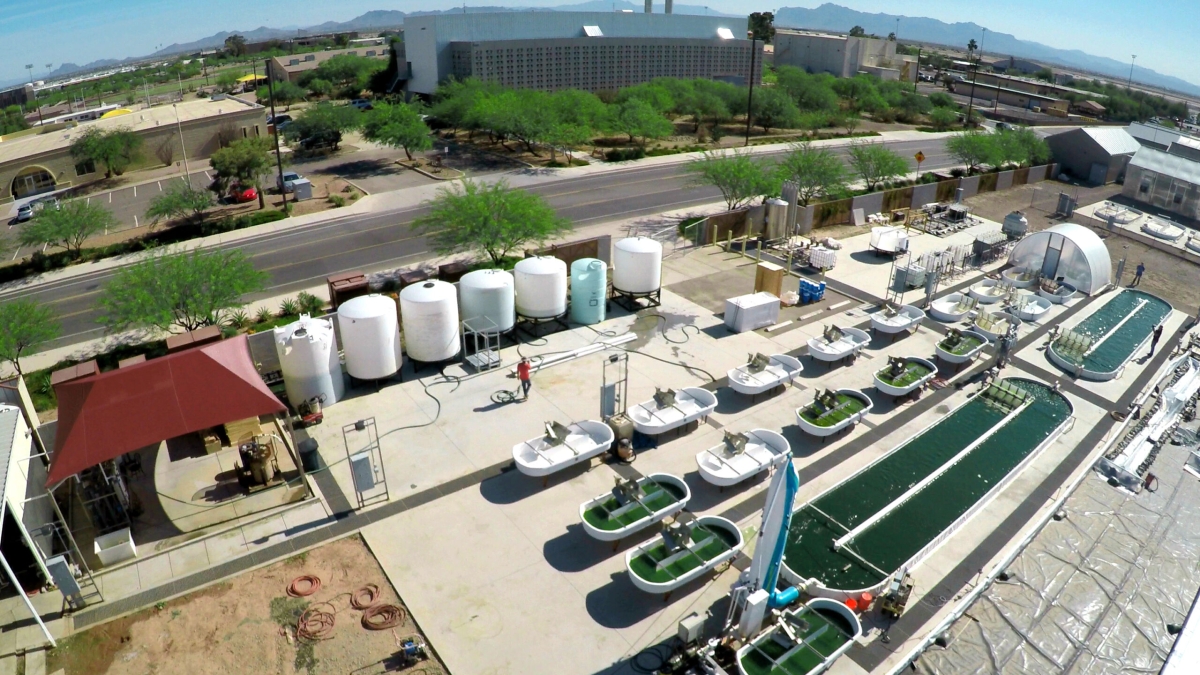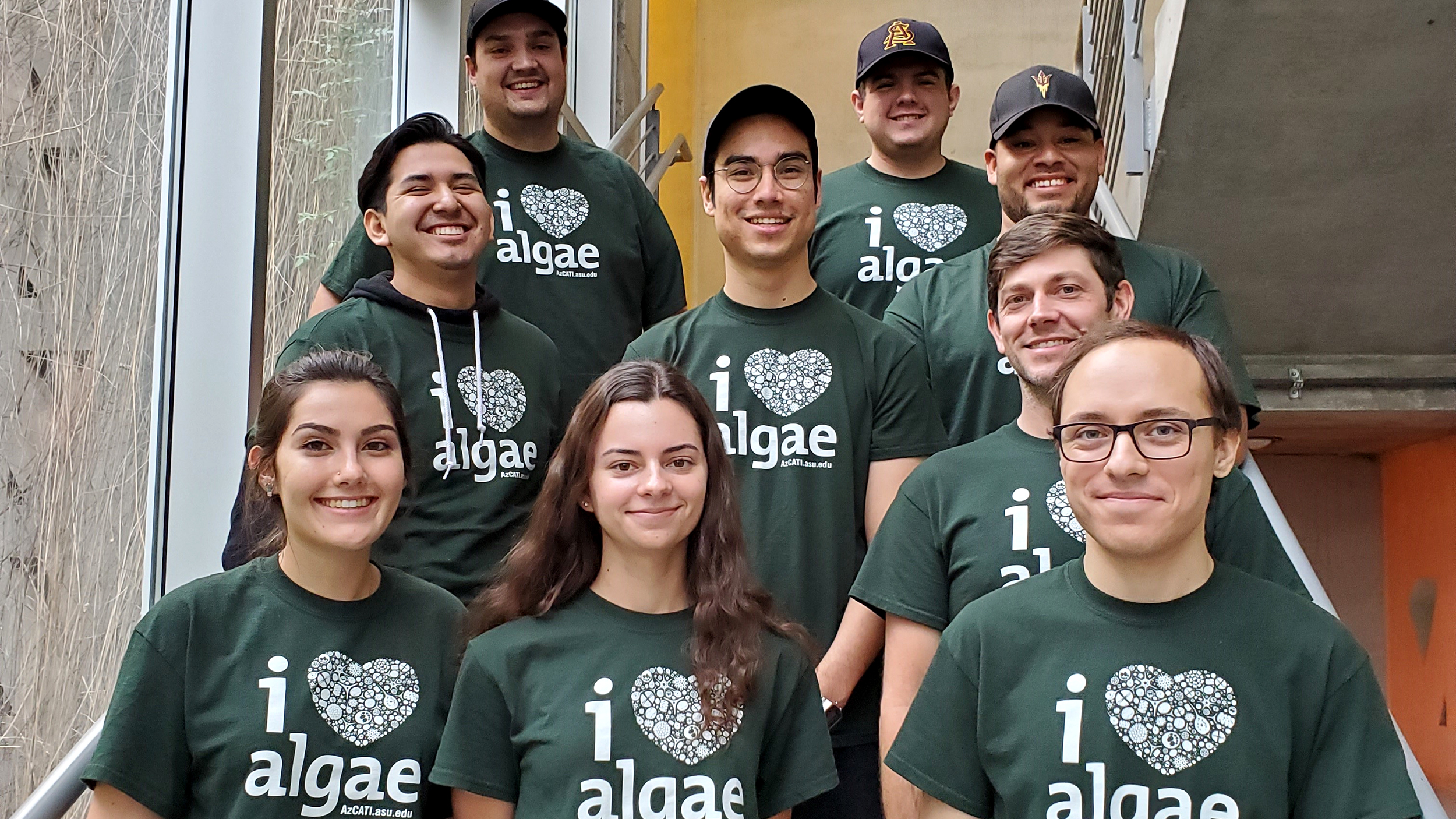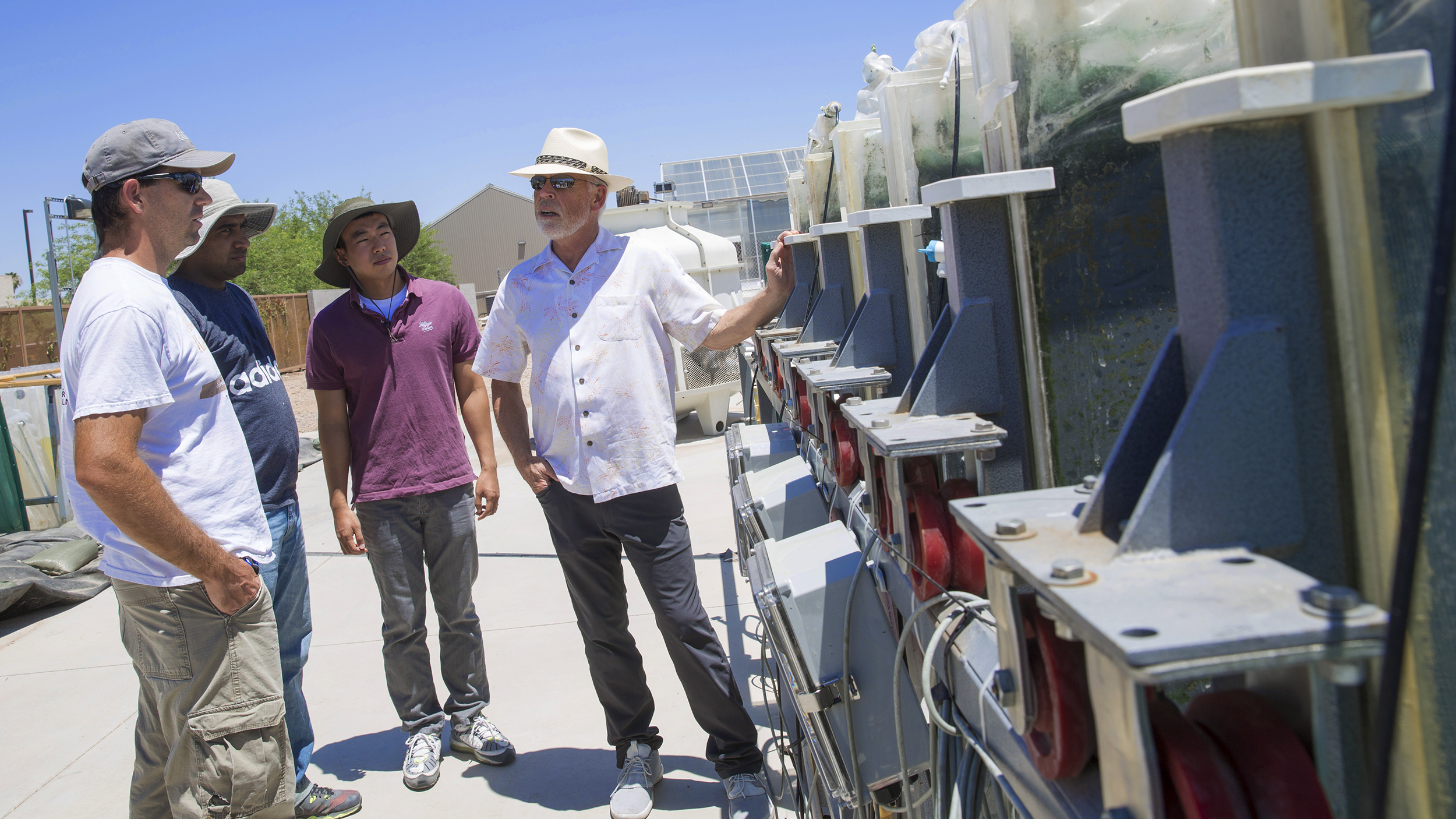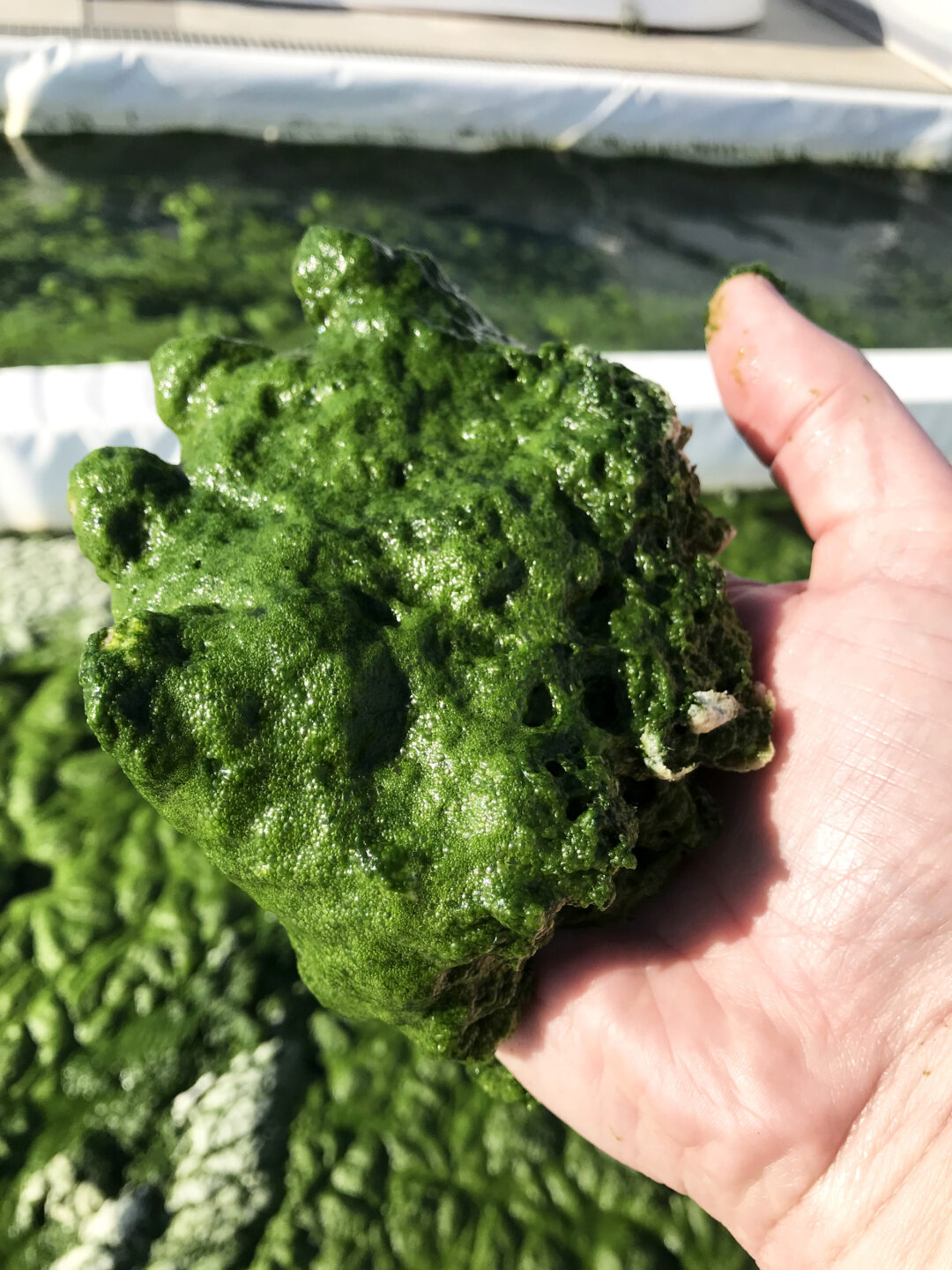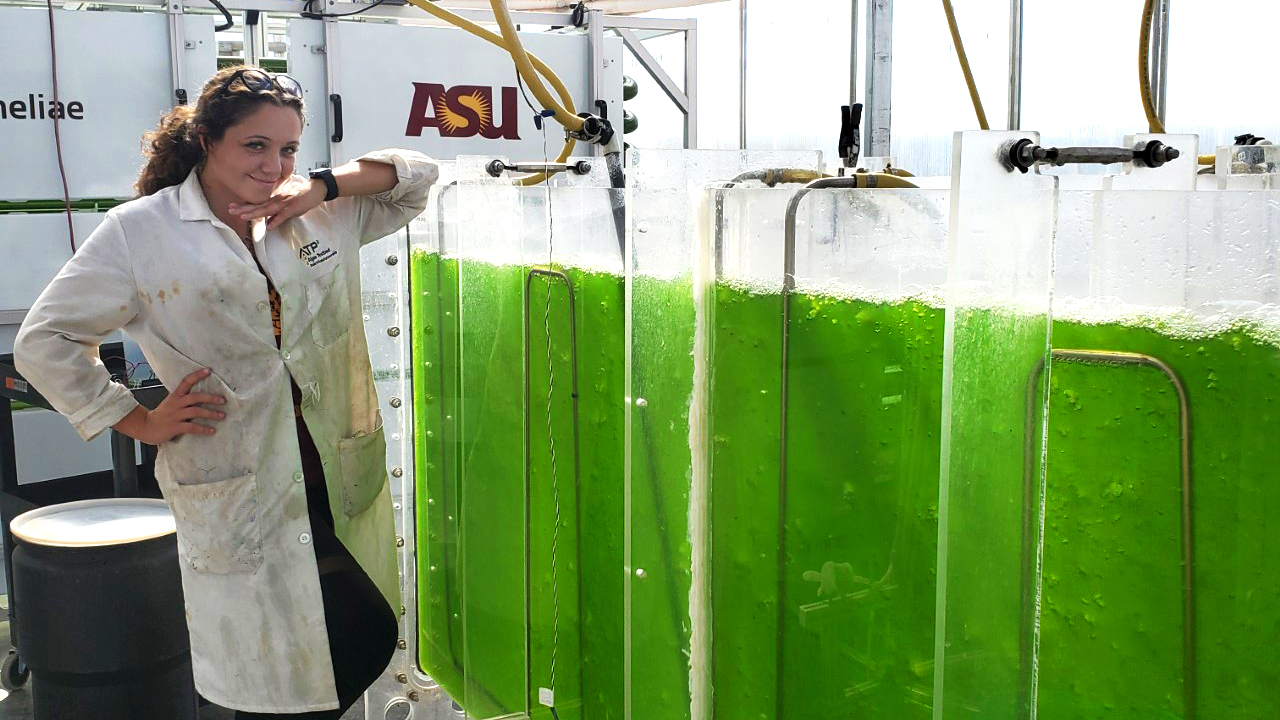Among ways being explored to combine biology and engineering to remedy a range of growing global environmental problems, algae-based solutions look especially promising.
The encouraging viewpoint stems from progress in research that is revealing how the properties of algae can be harnessed to become the driving force for a slew of productive biotechnological pursuits.
Some of the research findings have been the result of efforts based at the Arizona Center for Algae Technology and Innovation, or AzCATI, embedded in the Ira A. Fulton Schools of Engineering at Arizona State University.
Algae is an abundant and widely varied group of aquatic organisms capable of producing oxygen through photosynthesis and thereby harvesting energy from sunlight to grow and produce a range of biochemicals.
That capability and related characteristics can make algae a useful component in the development of advanced systems for effectively treating wastewater, producing cleaner energy and new biofuels, reducing harmful carbon dioxide emissions and improving decontamination and pollution control techniques.
Engineers and scientists say the chemical components in algae can also strengthen materials used to build transportation systems and other public infrastructure — while sequestering carbon in the process to substantially boost the sustainability of both natural and built environments.
An essential testbed site for algae-related industries
A group of recent and current student research assistants pose in their lab team T-shirts at the AzCATI facility. More than 150 ASU students have gotten valuable research experience at the Fulton Schools algae research center during its 10 years of operation, including those in degree programs in chemical engineering, human systems engineering, biochemistry and bioengineering, environmental resource management, sustainable food systems, natural resource ecology and astrophysics. Photo courtesy of AzCATI
AzCATI launched in 2010 with a multimillion-dollar investment from Science Foundation Arizona, a nonprofit with the mission of diversifying Arizona’s economy by aligning university research with the needs of industry.
The foundation’s support financed the development of several acres of algal growth ponds on ASU’s Polytechnic campus — located close to biochemical and molecular biology labs with resources available for use in AzCATI’s projects, particularly the cultivation of algal biomass for biofuels.
Before long, the center became one of the major testbeds for algae biotechnology-derived products, including nutraceuticals, biofuels, food and feed and high-value pharmaceuticals — all from algae biomass. This was possible due in large part to the Department of Energy-funded ATP3 consortium, which is designed to accelerate research and development of algae-based technologies.
“We’ve become basically the algae farmers for many public and private ventures that need to make advances in algae cultivation and productivity to reach their goals and our goals,” said John McGowen, AzCATI’s director of operations and an ASU sustainability scientist. “We collaborate with industry and academics to ‘road-test’ technology, and use data being generated by our testbed site to contribute to reducing technology risk and helping to propel the success of these enterprises.”
The center now has longstanding working relationships with major U.S. research facilities, including the National Renewable Energy Laboratory, the Pacific Northwest National Laboratory, Los Alamos National Laboratory and Sandia National Laboratories.
“Most of the national labs don’t have access to their own outdoor testing facilities, so they can come to us,” McGowen said. “Recently, through the DOE-funded DISCOVR consortium, we’ve achieved some of the highest outdoor algae cultivation productivity rates ever.”
Expanding applications of algae research and development
AzCATI’s leaders say many students and others who have worked at the center have gone on to use what they learned from the experience in their careers. Professor Peter Lammers (at right) is pictured in 2017 at the center’s testbed facilities with (left to right) Nick Csakan, a former AzCATI technician now working in a large California dairy converting manure to compressed natural gas to fuel buses; Thinesh Selvaratnam, a former postdoctoral researcher from Sri Lanka, now a professor at Lamar University in Texas; and Wonkun Park, a former postdoctoral researcher who is now a professor at Sangmyung University in Seoul, South Korea. Photo by Jessica Hochreiter/ASU
AzCATI is part of ASU’s LightWorks, an accelerator that focuses on advancing solar energy generation and other sources of sustainable energy, fuels and related products. The center is also part of the School of Sustainable Engineering and the Built Environment, one of the six Fulton Schools.
Through its connection to LightWorks and the school, AzCATI has been able to draw on a broad array of engineering and science resources and expertise, helping the center attract close to $70 million from public agencies, industry and foundations — as well as partnering with startups to obtain small business innovation grants — leading to significant expansion of AzCATI’s activities during its first decade.
Over that time, the use of algae in products has notably increased. Algae is now an ingredient in foods (for humans and animals), cosmetics, nutritional supplements like omega-3 oils, antioxidants, coloring agents, dyes for fabric, sunblock lotion, printing ink, flour and paper, among many other consumer products.
Beyond those uses, algae is a key ingredient in materials essential to a variety of industries. It’s often a key component of bioconcrete, the source of many bioplastics, and a growing source of agricultural biostimulants and fertilizers. Algae is used in aquaculture as feed for fish and shrimp, naturally imparting healthy antioxidants and omega-3 oils, along with appetizing colors, that don’t come from typical soymeal.
Looking at possibilities for expanding and improving the use of algae-based processes and technology to advance not only economic interests but also the greater societal good is the main thrust of research led by the three Fulton Schools faculty members on AzCATI’s leadership team. Each is contributing to innovation in what is called the Algae-Food/Energy/Water Nexus.
Research Professor Peter Lammers studies algae from acidic hot springs, applying his knowledge of molecular biology and environmental chemistry to create large-scale carbon-foundries that will fuel the future carbon economy.
Assistant Professor Taylor Weiss concentrates on making biochemical and biophysical advances, using synthetic biology and novel sensors to create and control the production of renewable biochemicals, sustainable agricultural additives, algal biofuels and products to improve human health.
Professor Shuguang Deng utilizes chemical engineering principles to develop adsorbents, catalysts and membranes for systems and technologies providing sustainable energy, chemicals, fuels and construction materials.
Attracting support from a range of public and commercial sources
Algae has myriad uses in a wide variety of industrial processes, biofuel production, food and health supplements, bioplastics, fertilizers, pollution control, waste treatment and ecosystem repair. Work at AzCATI is focusing on enhancing those uses while exploring new and impactful applications of algae-based technologies and systems. Photo courtesy of AzCATI
Research by Fulton Schools colleagues outside of AzCATI meshes with the center’s goals and helps support its ongoing projects.
Associate Professor Elham Fini is using an additive derived from algae to boost the resilience and reduce the emissions of asphalt — which is especially important in hot and sunny Arizona.
Professors Bruce Rittman and Rolf Halden’s work focuses on finding more effective methods of protecting and restoring the health of ecosystems.
In his Center for Negative Carbon Emissions, Professor Klaus Lackner is developing carbon capture technology to help pull harmful greenhouse gases out of the atmosphere.
Research capabilities in these and related areas over the years have brought AzCATI more than a dozen major projects funded by the U.S. Department of Energy, along with other projects supported by the Small Business Innovation Research programs of the U.S. Department of Agriculture and the National Institutes of Health.
Funding has also come from the Department of Energy’s Advanced Research Projects Agency-Energy, the Central Arizona Project — the aqueduct and canal system that brings water to much of central and southern Arizona — as well as numerous companies such as Xylem, a major multinational innovator in water technology.
Research collaborators rely on AzCATI’s expertise and creativity
Longtime AzCATI collaborators in industry, government agencies and research universities say the center has played an essential role in their research and development success.
Matthew Posewitz, a professor of chemistry at the Colorado School of Mines, has been in algae research field for more than 20 years and has worked on algae biofuels and related projects with support from the National Renewable Energy Laboratory and the Department of Energy.
“Some algae technology advances were pioneered at ASU dating back decades ago,” Posewitz said, “and the people at AzCATI continue to perform that level of work. They have been consistently at the forefront of algae testbed productivity. We have always been able to rely on the competence and creativity of the people there.”
Philip Pienkos has that same level of confidence in AzCATI’s researchers and technicians.
“I have always trusted them to do outstanding work and I always will,” said the biologist and recently retired emeritus scientist with the National Renewable Energy Lab.
His assertion is based on collaborations he was involved in with AzCATI since its early days, finding its leadership especially motivated to make breakthroughs in algae research.
“Once we decided what it was going to take to accomplish what we wanted to do, we could count on them getting the work done,” Pienkos said.
He recalls the first project he worked on with AzCATI researchers being an especially rewarding accomplishment. Together they provided the basis for a concept of an algae-based biorefinery, which led to the development of algae-based polyurethane, a plastic material with a plethora of practical uses.
Today, Pienkos is in the process of getting his own startup venture off the ground as a platform for commercializing urethane technology.
Helping to reverse direction on our unsustainable path
Madison Clar is pictured overseeing the processing of algae through a photobioreactor at the AzCATI research facilities. Clar began working at the center as an undergraduate and after earning her bachelor’s degree in applied biological sciences was hired as a staff member. She recently moved on to to a position at a cancer research institution. Clar’s path follows that of many student research assistants whose work with AzCATI has been a springboard to career opportunities. Photo courtesy of AzCATI
From a big-picture perspective, Lammers and Weiss say, solutions to the environmental threats posed by the increasing amounts of detritus — decomposing waste and debris — that is created by modern civilization lie at the nexus of AzCATI’s endeavors and related ASU research projects.
For example, conventional activated sludge treatment of municipal wastewater leads directly to 24 billion tons of carbon emitted as carbon dioxide. The AzCATI team is researching ways of using algae to turn wastewater treatment into a renewable carbon foundry that would replace petroleum as the primary feedstock for industrial carbon commodities.
AzCATI’s leaders say that engineering algae can help society change its unsustainable course. Algae-based technologies and systems could provide alternatives to wasteful and unsustainable practices that are causing environmental deterioration.
The researchers envision such an advance enabling development of effective and economical methods to clean up the damage that has already been done, while also spurring the development of new products — along with creating new jobs to better support communities and economies in an ever-growing world.
LightWorks Director Gary Dirks, who led the effort to establish AzCATI, says the center is at the leading edge of realizing the full potential of algae-based technology “to turn what is in those waste streams into valuable products.”
Such advances can contribute to creating “more sources of fuel, food, raw materials and chemical feedstocks to improve life in the future,” Dirks said.
Ram Pendyala, director of the School of Sustainable Engineering and the Built Environment, shares that outlook. AzCATI’s work “will lead to transformative algae-based technologies that fuel our societies and clean our environments in the years ahead,” Pendyala said.
Top photo: Research at the Arizona Center for Algae Technology and Innovation, or AzCATI, on Arizona State University’s Polytechnic campus is laying groundwork for algae-based technologies and systems to provide cleaner fuels, efficient wastewater treatment, environmental restoration and renewable chemical feedstocks. The center is part of ASU’s Ira A. Fulton Schools of Engineering. Photo courtesy of AzCATI
More Science and technology

Lucy's lasting legacy: Donald Johanson reflects on the discovery of a lifetime
Fifty years ago, in the dusty hills of Hadar, Ethiopia, a young paleoanthropologist, Donald Johanson, discovered what would become one of the most famous fossil skeletons of our lifetime — the 3.2…

ASU and Deca Technologies selected to lead $100M SHIELD USA project to strengthen U.S. semiconductor packaging capabilities
The National Institute of Standards and Technology — part of the U.S. Department of Commerce — announced today that it plans to award as much as $100 million to Arizona State University and Deca…

From food crops to cancer clinics: Lessons in extermination resistance
Just as crop-devouring insects evolve to resist pesticides, cancer cells can increase their lethality by developing resistance to treatment. In fact, most deaths from cancer are caused by the…
